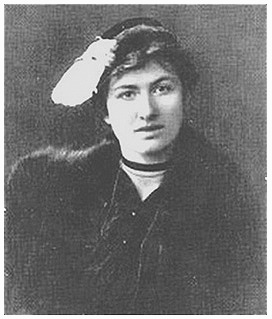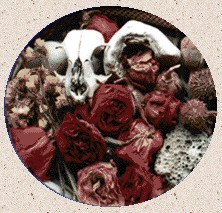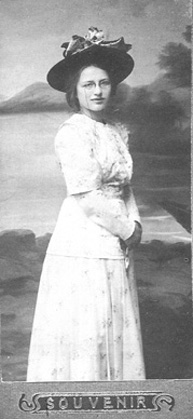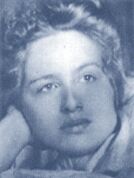


(329 pages)









The poems in this volume were born from suffering and loneliness. The reader discovers a person of great courage, understanding and love, someone whom one would have liked to have known. The Finnish-Swedish poetess Edith Södergran (1892-1923) knew that she was destined to die young and unloved by a man, despite her very erotic temperament. She had the classic disease of poets – tuberculosis. But she continued to write poetry of health and vigor, convinced that it was worth living if one overcame pain to become strong of soul. In her introductory note to the collection September Lyre, Edith wrote: “My self-confidence is due to the fact that I have discovered my dimensions. It is not becoming to make less of myself than I am.”This unique bilingual edition provides English-speaking readers with a nearly complete selection of her published poetry in English, and Swedish-speakers (as well as students of the Swedish language) with the original texts on the facing page of each poem.


The serene natural environment one encounters in her poetry was the scene of exploding grenades, machine-gun fire and terrible bloodshed. Edith had heard machine-guns sputtering in Raivola in 1918 during the mutual slaughter of the red and white guards. Battle-weary Swedish-speaking officers were quartered in the home of Edith and her widowed mother after a decisive battle. Twenty years after her death, nearby St. Petersburg (then called Leningrad), where she had gone to a private girls’ school, was bombarded by German cannons. The entire Baltic region underwent epic changes as a result of the epic violence. (She and her mother were in St. Petersburg in 1917 during the tumult of the revolution.) Edith Södergran's poems reflect her inner exile from the civilization that unleashed such wasteful violence and carnage, inner exile that is the traditional lot of the poet. One of the last poems she wrote before her death from tuberculosis reveals a longing for landet som icke är,
”the land that is not,” an echo of her ultimate detachment from the chaotic human society around her. The Land that Is Not can be likened to the Homeland of Nothing Whatsoever of the ancient Chinese sage Chuang Tzu. Such a view can give rise to accusations of escapism, apathy and indifference. But in Edith Södergran’s case, it can be seen as spiritual strength of the highest order. Her clairvoyance gave her deep contact with what she called the Mystery. For Chuang Tzu and the other taoist sages it was Tao – the Way. Edith described the Mystery in a manner similar to the taoist descriptions of the Way: ”Mystery, I recognize you, I, the anti-mystic, the enemy of ghosts./ Mysteries have no clear boundaries, mysteries have no utterable name.” (”Instinct")
Edith Södergran’s childhood unfolded under the curse her grandmother called down over her own son, Matts Södergran, Edith’s father. By selling the farm that belonged to his family for generations, Matts provoked his mother’s curse for ”the worst misfortune” to afflict him. The subsequent break with his mother isolated Matts’ daughter from this side of her family, and as if heeding the curse called down on him, Matts Södergran wasted his wife’s inheritance and sank into alcoholism and tuberculosis. It was an unhappy marriage with many conflicts. Edith’s mother was, unlike her father, well-read and cultivated, and from her she acquired a taste for poetry and books. The cursed marriage led to her mother doting on Edith (an only child), whom she adored all her life. The little girl loved reading fairy tales, and grew up in her own fairy tale. Some of her later poems reveal the gestalt of the Fairy Queen. She was very lonely for playmates, especially after a foster sister ran away in St. Petersburg (where Edith had begun school) and, thinking to follow the train tracks back to Raivola, was run over by a train and killed. At the age of twenty-seven Edith corresponded with a female journalist in Helsinki named Hagar Olsson, and even before she had met her soon-to-be best friend, she wrote that she now had a ”playmate”. In a poem she rejoices over having ”found a sister.”
Her first letter to Hagar Olsson is astonishing. That Olsson responded and became a close friend to the poet must mean that she was exceptional in her instinct for poetry, which she wrote as well. Edith wrote in her letter to Hagar: ”My offensive has been let loose on you (Eder, the formal ’you’). I would like you to see me as the one I really am, and show me yourself as the one you are. Can we associate divinely with each other, so that all the barriers fall?" (January 11, 1919) (...) Edith Södergran's first published book of poetry, Dikter (Poems), in 1916, was met with incomprehension by the critics. Some had haughty contempt for the new poems, like the man who called them dårdikter (lunatic poems). Her poems were considered scandalous. In one desperate letter to her publisher she asked for an official disclaimer that a certain Edith Sörensen was not the author of the volume. It seems that the woman with the same first name and a similar last name was harassed and made miserable for supposedly having written such terrible things. Not all the critics were hostile. One saw
”a great musical precision, a perceptive intuition for the value of words and colors." Despite her "nervous lyrics" , the same critic saw "a genuine skald's temprament." Hagar Olsson defended Edith Södergran in print from accusations of delusions of grandeur by reviewers of her poetry, writing that the belief that all are equal before God is a lie. This comfortable lie, Hagar continued, smothers those few claivoyant souls ”who have been cleansed through suffering, those whom the masses do not know and consequently do not understand.” Unlike Nietzsche, who greatly influenced her poetry, Edith did not succomb to vanvettets virvelstup,
”insanity’s maelström”.
When she was thirteen Edith’s father fell sick with tuberculosis. The girl consoled her sick father with kisses, while the mother tried to prevent her, fearing the worst. Alas, Edith’s kisses for her dying father condemned her to a premature death, the final portion of her grandmother’s curse on Matts Södergran. The rest of her life was marked by fits of coughing, long stays in sanitariums, long stays in bed. Nonetheless, she was able to go to a German school in St. Petersburg, along with girls from the Baltic countries, Russia, Finland, Poland and Germany.
For any poet, fluency in foreign languages enriches the diction of the mother tongue, as Chaucer’s daily use of French as ambassador in Paris brought so much wealth to the English language. At the beginning of her switch to her mother tongue, Edith showed better mastery of German than Swedish. She had been intensely studying Goethe, Heine and other German poets, whereas she had read very little Swedish poetry. She grew up outside the boundaries of Swedish culture, just as Jules Laforgue and Isidore Ducasse (”le comte de Lautréamont”) grew up outside of French culture in Montevideo, Uruguay. She spoke an old-fashioned Swedish, often grammatically incorrect.
At sixteen she found out she had the same illness of which her father died. But Edith Södergran should not be seen as the legendary frail and sick poet coughing up blood (as Dylan Thomas so desperately tried to be). Despite her tuberculosis, she maintained spiritual health and strength that made her friend Hagar Olsson say of her: ”In that fragile woman’s body lived a burning activity and willpower that, if liberated, as in the shape of a commander-in-chief, could overturn worlds.”
Side by side in Edith's poetry are powerful opposites. She saw herself as eld och vatten (fire and water) and was both erotically rebellious and submissive towards men whom she loved (most often at an impossible distance). After several stays at sanitariums in Switzerland (where she fell in love with the doctor), she returned to a life of total isolation in Raivola. Alone with her language and her illness, she proceeded to infuse the Swedish tongue with a fresh and vigorous music, and with her knowledge of German, Russian and French giving power to her eloquence, she flowered into one of the greats of Swedish poetry before her death at the age of thirty-one.(...)
After a rather unsuccessful visit to Helsinki to hobnob with Finland’s literati in 1917, Edith returned to Raivola and her extreme isolation and solitude. She was seen as a unique talent by some of her colleagues, but their reaction was tame and complacent. She depicted them in a poem as a hornless bull, oblivious to the matador’s cape, munching on hay as the red cloth fluttered ”unpunished” in the wind. And yet, she was very grateful for the
”immeasurable service” the publisher rendered her. (...) Even before reviews of Septemberlyran came out in the newspapers, she sent a letter to the editor to clarify that her book was neither written for the public nor intellectual circles, but for ” those few individuals standing closest to the boundary of the future.” In the same letter she stated that ”the earth belongs to those who bear the highest music within themselves. I address those rare individuals and challenge them to lift up their inner music, the same as building the future. I myself sacrifice every atom of my power to my lofty goal, I live the life of a saint.” She did not advocate the destruction of the existing (malfunctioning) order as did the bolsheviks: ”I regard the old world order as the mother cell, which should be maintained until these individuals raise the new world order.” Here we hear a clear echo of Nietzsche, but without the lunacy that plagued the German’s later works. Edith regarded herself as ”a new species of individual, the first rightful heir to Zarathustra’s teachings to come forward.” (The only shortcoming in this declaration is that Zarathustra was a fictitious literary creation of a man who was not a bonafide poet.) Her rallying cry, like Nietzsche’s, turned out to be mere wishful thinking, for eighty years after Septemberlyran the
"highest music" is even more distant from our age than it was from hers, drowned out by hard-rock, rap, and high-pressure advertising. The rare individuals to whom Edith Södergran addressed her poems remain isolated readers sighing in disbelief at the world crumbling around them. Towards the end of her life, when she had rejected Poetry and Art for Jesus and Rudolf Steiner, Edith neglected her appearance when before it was important to her. (She had previously written of her ”great aversion to mysticism, religion and Christianity.”) She became den tokiga fröken – the crazy girl - for the villagers of Raivola, who knew nothing of her status as poet. When a villager maliciously killed her beloved cat Tottie, she was crushed. They mimicked the way she walked, the way she stood still, staring up at the sky in silence.
The lonely woman knew she was destined to die young and unloved by a man, despite her very erotic temperament. She had the classic disease of poets. Like Keats, she coughed up blood, and like him, she caught the contagion from a family member. But she continued to write poetry of health and vigor (despite her vow rejecting Art), convinced that it was worth living if one overcame pain and became strong of soul. Her biographer Gunnar Tideström commented that the immeasurable self-assertion in her poetry has shocked certain readers into believing it to be ”pathological”. Tideström opposed such a belief: ”It is especially repugnant to use the word ’pathological’ , which carries the meaning of unfit for life, when referring to a person who emanates extraordinary vitality in circumstances where most other people would perish.”
(She danced for autumn on yellow carpets
”Death of the Virgin”
Stockholm,Sweden
Edith Södergran was born in the Finnish village Raivola on April 4, 1892. Finns, Swedes and Russians lived in close proximity in this village, fifty kilometers northwest of St. Petersburg on the Baltic sea. The violence of World Wars I and II swept over Raivola three times, and much has changed since the poetess was a child there. Her home was burned down, her tombstone was stolen, and many of the inhabitants were dispersed after many generations of residence there.
 The beloved natural landscape around her she called her
”garden”, a forest of maples, birches, elms and spruce with a lake below where she liked to sunbathe in nakedness. The reader may be wondering why this major poet of the Swedish language was a native of Finland, in a village where mostly Finnish was spoken. From the time of Karl XII’s conquests around the Baltic in the 18th century there has been a Swedish-speaking community on the Baltic coast of Finland. Many Finnish-speaking Finns as well are fluent speakers of Swedish today, although the two languages are not at all related linguistically, as are Swedish and Norwegian. Swedes in Sweden immediately recognize the thick accent of Finland’s Swedes, which was the accent of Edith Södergran. One can imagine how she sounded listening to the actress Stina Ekblad, herself a Finland-Swede, recite Södergran’s verses in Stockholm.”)
The beloved natural landscape around her she called her
”garden”, a forest of maples, birches, elms and spruce with a lake below where she liked to sunbathe in nakedness. The reader may be wondering why this major poet of the Swedish language was a native of Finland, in a village where mostly Finnish was spoken. From the time of Karl XII’s conquests around the Baltic in the 18th century there has been a Swedish-speaking community on the Baltic coast of Finland. Many Finnish-speaking Finns as well are fluent speakers of Swedish today, although the two languages are not at all related linguistically, as are Swedish and Norwegian. Swedes in Sweden immediately recognize the thick accent of Finland’s Swedes, which was the accent of Edith Södergran. One can imagine how she sounded listening to the actress Stina Ekblad, herself a Finland-Swede, recite Södergran’s verses in Stockholm.”) Her first poems fill a school notebook, 225 altogether, never published. Most of these youthful poems were written in German – only 10% in her mother tongue, Swedish. At fourteen Edith Södergran had become a cosmopolitan, reading Heine, Goethe, and other classical poetry in French, Russian, German and Swedish. One day she wrote in her notebook, Ich weiss nicht, in wessen Sprache schreiben (”I don’t know in which language to write”). At this point in her writing a long series of poems in German comes to an end. After one poem in French, she now began to write exclusively in Swedish.
Her first poems fill a school notebook, 225 altogether, never published. Most of these youthful poems were written in German – only 10% in her mother tongue, Swedish. At fourteen Edith Södergran had become a cosmopolitan, reading Heine, Goethe, and other classical poetry in French, Russian, German and Swedish. One day she wrote in her notebook, Ich weiss nicht, in wessen Sprache schreiben (”I don’t know in which language to write”). At this point in her writing a long series of poems in German comes to an end. After one poem in French, she now began to write exclusively in Swedish.Nor did her publisher understand her. She did not like the liberties he took with her volume Septemberlyran (September Lyre) from 1918. A picture of a hooved devil on the cover was not her choice, nor was the underlining of one line in a poem: lätta och lustiga som beväpnade djävlar – ”light and strange like armed devils.” She was very displeased that the publisher
”crowned the whole with a devil,” liberty-taking that is reminiscent of the grammatical vandalism done to Emily Dickinson’s poetry by a male editor who as well did not understand her.
 This is no exaggeration. Having survived her last severe nordic winter with nightly cramps and attacks of smothering, ”500 electric needles” in her hands, spitting blood, isolated, hungry and dying, Edith could nonetheless write in a letter: ”I feel quite happy, I have no desires for us (her mother and herself).” She died on midsummer day 1923. Her mother destroyed all of Edith's letters that she could find, in accordance with her daughter's wishes. Edith had written to a young Swedish-Finnish poet, Elmer Diktonius (dikt = poem in Swedish), on her birthday, April 4, 1922: "But make a sacred vow that my letters never fall into the hands of the cadaver-worms who write biographies." That very letter ironically fell into the hands of the literary "cadaver-worms" and was preserved for posterity. Otherwise, most of her letters were burned. (The few remaining letters were recently published in Stockholm as edited by Agneta Rahikainen.) The two last poems written by Edith Södergran, found by her mother after the funeral, begin this volume, and proceed in reverse chronological order to her early poems.
This is no exaggeration. Having survived her last severe nordic winter with nightly cramps and attacks of smothering, ”500 electric needles” in her hands, spitting blood, isolated, hungry and dying, Edith could nonetheless write in a letter: ”I feel quite happy, I have no desires for us (her mother and herself).” She died on midsummer day 1923. Her mother destroyed all of Edith's letters that she could find, in accordance with her daughter's wishes. Edith had written to a young Swedish-Finnish poet, Elmer Diktonius (dikt = poem in Swedish), on her birthday, April 4, 1922: "But make a sacred vow that my letters never fall into the hands of the cadaver-worms who write biographies." That very letter ironically fell into the hands of the literary "cadaver-worms" and was preserved for posterity. Otherwise, most of her letters were burned. (The few remaining letters were recently published in Stockholm as edited by Agneta Rahikainen.) The two last poems written by Edith Södergran, found by her mother after the funeral, begin this volume, and proceed in reverse chronological order to her early poems.
Hon dansade för hösten på gulnade mattor
hon kröp ihop och virvlade – och sjönk och slocknade.
she huddled and swirled – and sank and went out.)
June 21, 2003 (Midsummer day)
”Thank you for a beautiful beautiful book!”
(first buyer, Copenhagen, January 2006)


